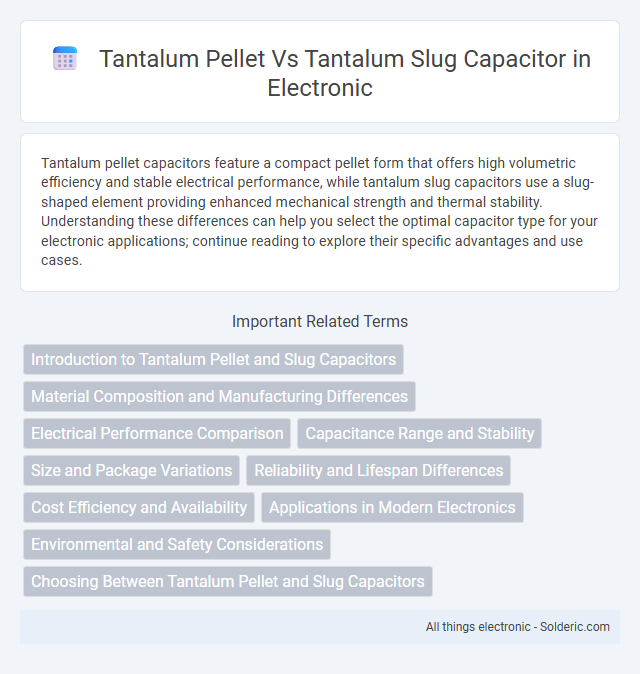Tantalum pellet capacitors feature a compact pellet form that offers high volumetric efficiency and stable electrical performance, while tantalum slug capacitors use a slug-shaped element providing enhanced mechanical strength and thermal stability. Understanding these differences can help you select the optimal capacitor type for your electronic applications; continue reading to explore their specific advantages and use cases.
Comparison Table
| Feature | Tantalum Pellet Capacitor | Tantalum Slug Capacitor |
|---|---|---|
| Material Form | Pressed tantalum powder pellet | Solid tantalum slug (machined rod) |
| Manufacturing Process | Pelletized powder sintered into shape | Machined or shaped solid tantalum slug |
| Capacitance Range | Low to moderate capacitance values | Higher capacitance possible due to denser material |
| Cost Efficiency | Generally lower cost, mass production friendly | Higher cost due to complex machining |
| Reliability | Stable performance, prone to fewer mechanical failures | Very stable, often used in high-reliability applications |
| Application | Consumer electronics, general use | Military, aerospace, and high-stress environments |
| Physical Size | Compact, varies with capacitance | Bulkier due to solid structure |
Introduction to Tantalum Pellet and Slug Capacitors
Tantalum pellet capacitors consist of tiny sintered tantalum powder pellets acting as the anode, offering high capacitance in compact sizes with excellent frequency characteristics and reliability. Tantalum slug capacitors use a solid tantalum slug as the anode, providing enhanced stability and robustness under high surge conditions but typically with lower capacitance density. Both capacitor types leverage tantalum's high volumetric efficiency and stable oxide layer dielectric, making them critical in miniaturized electronics requiring durable, high-performance capacitive components.
Material Composition and Manufacturing Differences
Tantalum pellets are small, cylindrical pieces of sintered tantalum powder used as the anode material in capacitors, offering high purity and uniform grain structure. Tantalum slugs, on the other hand, are machined from solid tantalum metal, resulting in a denser and more mechanically robust anode but with less surface area for oxide film formation. Understanding these material compositions and manufacturing differences can help you select the optimal capacitor type for applications requiring specific performance characteristics such as stability, capacitance, and size.
Electrical Performance Comparison
Tantalum pellet capacitors exhibit lower equivalent series resistance (ESR) and better frequency response compared to tantalum slug capacitors, resulting in improved high-frequency performance and reduced power loss. Tantalum slug capacitors typically offer higher volumetric efficiency and greater capacitance stability under varying temperatures, but their ESR is generally higher, limiting performance in high-frequency applications. Electrical performance optimization depends on the specific application requirements, with tantalum pellets favored for advanced, low-ESR needs and tantalum slugs suitable for stable, bulk capacitance solutions.
Capacitance Range and Stability
Tantalum pellet capacitors typically offer a capacitance range from 1 uF to 470 uF with excellent stability over temperature and frequency, making them ideal for applications requiring reliable performance in compact sizes. Tantalum slug capacitors provide a broader capacitance range, often extending up to several thousand microfarads, but may exhibit slightly less stability under varying environmental conditions. For your design needs, selecting between pellet and slug tantalum capacitors depends on the desired balance between capacitance value and stability requirements.
Size and Package Variations
Tantalum pellets are small, compact, and versatile, typically used in miniature capacitor applications allowing for tighter circuit designs. Tantalum slugs, larger and more robust, provide enhanced capacitance values in bulkier package options suitable for high-reliability power systems. Variations in size and packaging of these tantalum components directly impact thermal dissipation and voltage handling capabilities, influencing their selection in electronic circuit design.
Reliability and Lifespan Differences
Tantalum pellet capacitors generally offer higher reliability due to their compact and uniform pellet structure, which reduces internal defects and enhances thermal stability. Tantalum slug capacitors, while robust, may have a shorter lifespan because the slug design can introduce mechanical stress points that impact long-term durability. Your choice should consider that pellet capacitors typically deliver longer operational life in high-stress electronic applications.
Cost Efficiency and Availability
Tantalum pellet capacitors generally offer greater cost efficiency due to simpler manufacturing processes and lower material waste compared to tantalum slug capacitors. The widespread availability of pellets as raw materials ensures consistent supply and competitive pricing, making them a preferred choice for large-scale production. Your selection of pellet capacitors can reduce overall component costs while maintaining reliable performance in electronic applications.
Applications in Modern Electronics
Tantalum pellet capacitors excel in miniaturized devices requiring high capacitance in compact volumes, making them ideal for smartphones, wearables, and medical implants. Tantalum slug capacitors offer superior stability and reliability under extreme conditions, favored in aerospace, military, and high-performance industrial electronics. Your choice between pellets and slugs depends on the balance between size constraints and robust operational demands in cutting-edge electronic applications.
Environmental and Safety Considerations
Tantalum slug capacitors pose higher safety risks due to potential combustion under electrical stress, whereas tantalum pellet capacitors generally offer improved thermal stability and reduced fire hazards. Environmental considerations highlight that pellet capacitors often require less aggressive manufacturing processes, limiting toxic waste and pollution. Your choice of capacitor can influence both operational safety and ecological impact, favoring pellet designs for enhanced compliance with environmental regulations.
Choosing Between Tantalum Pellet and Slug Capacitors
Tantalum pellet capacitors offer high volumetric efficiency and stable capacitance, making them ideal for space-constrained applications requiring reliable performance. Tantalum slug capacitors provide enhanced surge current tolerance and improved mechanical robustness, suitable for high-stress environments and power electronics. Selecting between pellet and slug variants depends on factors like current handling requirements, environmental conditions, and device size limitations.
tantalum pellet vs tantalum slug capacitor Infographic

 solderic.com
solderic.com